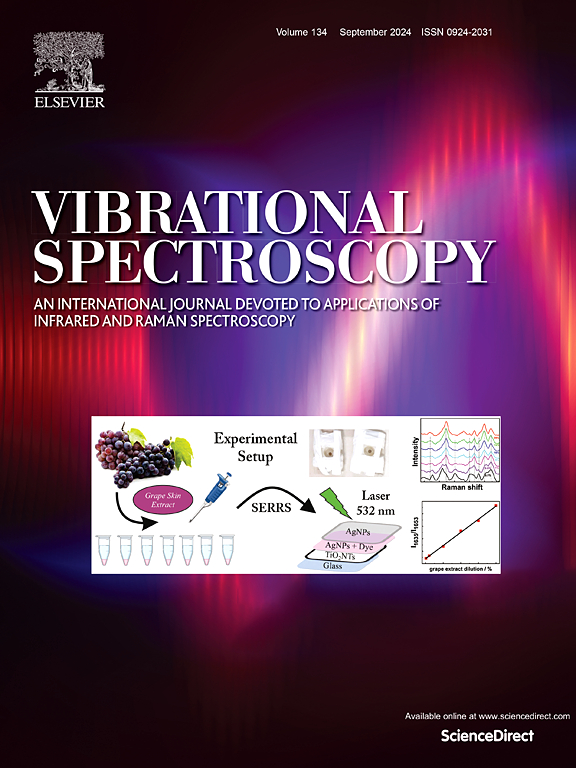Vibrational spectroscopy of urine combined with support vector machine for lupus nephritis diagnosis research
IF 3.1
3区 化学
Q2 CHEMISTRY, ANALYTICAL
引用次数: 0
Abstract
Lupus nephritis (LN) is one of the most common and serious organ manifestations of systemic lupus erythematosus (SLE), with a poor long-term prognosis and a complex diagnostic process, therefore it is important to find a simple, rapid and non-invasive method for the diagnosis of LN. This study investigated the feasibility of using surface-enhanced Raman spectroscopy (SERS) and Fourier Transform Infrared (FT-IR) spectroscopy of urine samples to classify healthy volunteers and LN patients. SERS and FT-IR data of urine samples were obtained from 100 LN patients and 100 healthy volunteers. To verify the stability of the classification algorithm, 50 independent experiments were conducted. In each experiment, the dataset was randomly divided and a classification model was established using the support vector machine (SVM) algorithm (linear kernel function). Meanwhile, it was compared with four other common classification algorithms and the results showed that SVM model had the best effect. The average classification accuracy of SERS and FT-IR spectra combined with SVM model for 50 independent experiments reached 96.97 % and 92.77 %, respectively. In addition, the features of SERS and FT-IR were spliced and then combined with SVM model for classification, corresponding to an average classification accuracy of 97.63 %. Subsequently, genetic algorithm was used to perform feature selection on the spliced features, and the 16 selected features were also input into SVM model, with an average classification accuracy of 99.47 % over 50 independent experiments. Therefore, urine vibrational spectroscopy combined with SVM model has great potential in the diagnosis of lupus nephritis.
尿液振动光谱结合支持向量机诊断狼疮性肾炎的研究
狼疮肾炎(Lupus nephroritis, LN)是系统性红斑狼疮(SLE)最常见、最严重的器官表现之一,长期预后差,诊断过程复杂,因此寻找一种简单、快速、无创的诊断方法具有重要意义。本研究探讨了利用尿液样本的表面增强拉曼光谱(SERS)和傅里叶变换红外光谱(FT-IR)对健康志愿者和LN患者进行分类的可行性。获得100例LN患者和100名健康志愿者尿液样本的SERS和FT-IR数据。为了验证分类算法的稳定性,我们进行了50个独立的实验。在每个实验中,随机划分数据集,并使用支持向量机(SVM)算法(线性核函数)建立分类模型。同时,将其与其他四种常用分类算法进行比较,结果表明SVM模型的分类效果最好。50个独立实验中,SERS和FT-IR光谱结合SVM模型的平均分类准确率分别达到96.97 %和92.77 %。此外,将SERS和FT-IR的特征拼接后,结合SVM模型进行分类,对应的平均分类准确率为97.63 %。随后,利用遗传算法对拼接后的特征进行特征选择,并将选择的16个特征输入到SVM模型中,经过50次独立实验,平均分类准确率达到99.47 %。因此,尿液振动光谱结合SVM模型在狼疮性肾炎的诊断中具有很大的潜力。
本文章由计算机程序翻译,如有差异,请以英文原文为准。
求助全文
约1分钟内获得全文
求助全文
来源期刊

Vibrational Spectroscopy
化学-分析化学
CiteScore
4.70
自引率
4.00%
发文量
103
审稿时长
52 days
期刊介绍:
Vibrational Spectroscopy provides a vehicle for the publication of original research that focuses on vibrational spectroscopy. This covers infrared, near-infrared and Raman spectroscopies and publishes papers dealing with developments in applications, theory, techniques and instrumentation.
The topics covered by the journal include:
Sampling techniques,
Vibrational spectroscopy coupled with separation techniques,
Instrumentation (Fourier transform, conventional and laser based),
Data manipulation,
Spectra-structure correlation and group frequencies.
The application areas covered include:
Analytical chemistry,
Bio-organic and bio-inorganic chemistry,
Organic chemistry,
Inorganic chemistry,
Catalysis,
Environmental science,
Industrial chemistry,
Materials science,
Physical chemistry,
Polymer science,
Process control,
Specialized problem solving.
 求助内容:
求助内容: 应助结果提醒方式:
应助结果提醒方式:


